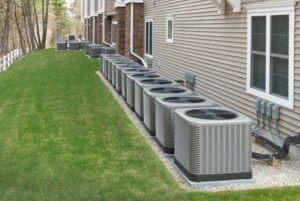Changing Seasons Are Coming — Energy-Saving Tips for Your Highland Park Home
 It’s been another beautiful summer in Highland Park and, as usual, it seems to have gone by too fast. Before we know it, cold weather will be keeping us inside where it’s warm and comfortable. If you’re looking forward to winter but dreading the high energy bills that typically come with it, there are quite a few things you can do while the temperature is warm to get your home ready for the heating season. These energy-saving tips will help you save a considerable amount of money on your utility bills.
It’s been another beautiful summer in Highland Park and, as usual, it seems to have gone by too fast. Before we know it, cold weather will be keeping us inside where it’s warm and comfortable. If you’re looking forward to winter but dreading the high energy bills that typically come with it, there are quite a few things you can do while the temperature is warm to get your home ready for the heating season. These energy-saving tips will help you save a considerable amount of money on your utility bills.
Maintain Your HVAC System
Heating and cooling your home accounts for about half of your annual utility costs. A well-maintained system not only operates more efficiently to save you money on home comfort, but it will also last longer, emit less carbon dioxide, experience fewer common problems and help ensure optimum safety. Fall is the best time to schedule your annual preventive maintenance with a reputable contractor. Your technician will perform a variety of tasks, including tightening gas and electrical connections; inspecting gas lines, wires and terminals; inspecting the vent stack or chimney flue and checking for carbon monoxide leaks; and inspecting the ductwork and thermostat.
Stock up now on good-quality air filters and check the HVAC filter monthly for dust buildup. Replace it when it’s clogged with dust to ensure optimum airflow and comfort, as well as improve indoor air quality.
Seal Air Leaks
No matter how efficient your heating system is, it will cost more to heat the home if you have air leaks. Common sites of air leaks include:
- Windows and doors. Seal movable components with weatherstripping and apply caulk around the stationary components.
- Baseboards. Caulk along the top and bottom of drafty baseboards.
- Service entrances. Use caulk to seal small gaps around cable and phone lines, and apply expandable caulk to larger gaps around vents and pipes that lead outdoors.
- Recessed lighting fixtures. Caulk around the space between the light fixture and the ceiling.
- Outlets and switch plates on exterior walls. Remove the cover plates, set pre-cut sealing gaskets into place, and replace the covers.
Insulate the Attic
Inadequate attic insulation means higher heating and cooling bills. Check the attic insulation, and shore it up if there’s less than 15 inches of R-38 insulation. Insulation batts are fairly inexpensive and easy to install yourself.
Seal and Insulate Ductwork
Leaky ductwork can leak out up to 40 percent of the air that moves through the ducts, wasting heat and energy dollars. Energy-saving tips for ductwork include these tasks:
- Seal loose duct joints with mastic sealant or metal tape.
- Check for loose connections between the ducts and the main unit, and between the ducts and the registers, and seal them with spray foam or caulk.
- Insulate ductwork that runs through crawlspaces, the attic, and other unconditioned spaces to keep the air inside warm and to prevent condensation, which can promote mold growth.
Install a Programmable Thermostat
A properly installed and programmed programmable thermostat can save you a lot of money on heating and cooling the home. Program your thermostat back 10 to 12 degrees while you’re at work or sleeping, which will save you up to 10 percent on your heating bills when done consistently for eight-hour periods. While you’re at home, keep the thermostat set at 68 degrees.
Maintain Your Water Heater
Heating water accounts for about 18 to 25 percent of your annual utilities. These energy-saving tips for the water heater can reduce costs by up to 9 percent.
- Flush the tank every year or two to remove sediment, which acts as insulation between the heating element and the water inside.
- Insulate the exposed hot and cold water pipes with pre-cut foam pipe insulation.
- Install an insulating jacket on the tank to keep the water inside hotter.
- Set the water heater thermostat to 120 degrees to save energy and prevent scalding, sediment buildup in the tank, and corrosion.
- Install low-flow faucet and shower heads to reduce the amount of hot water you use.
- Wash your clothes in cold water and run the shortest cycle on the dishwasher whenever possible.
Reverse Ceiling Fan Blades
Flip the switch at the top of your ceiling fans to reverse the direction of the blades, which will help distribute warm air near the ceiling downward and into the far corners of the room. Run the fans on low speed. Just don’t forget to switch the blade direction back to counter-clockwise when spring arrives.
For more energy-saving tips for year-round savings on your utility bills, please contact us in the Highland Park area at Carefree Comfort, Inc. Heating & Air Conditioning.
Image Provided by Shutterstock.com
You May Also Like

Should My Heat Pump Sound So Noisy in Lake Bluff, IL?
Heat pumps should work not only efficiently but quietly. If any strange sounds begin disturbing the peace of your home, we strongly… Continue Reading Should My Heat Pump Sound So Noisy in Lake Bluff, IL?…

How UV Lights Work to Improve the Air Quality of Deerfield Homes
In the quest for a healthier home environment, many homeowners are turning to a powerful ally – UV-C light. Ultraviolet (UV) light,… Continue Reading How UV Lights Work to Improve the Air Quality of Deerfield Homes…

Should My Furnace in Lincolnshire, IL, Sound So Loud?
Malfunctioning furnaces behave strangely while regulating indoor temperatures. One of the odd things a faulty furnace does is produce loud sounds. Let’s… Continue Reading Should My Furnace in Lincolnshire, IL, Sound So Loud?…
